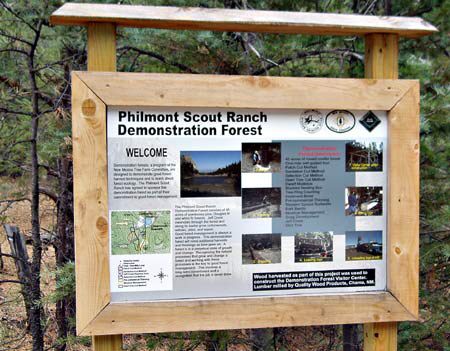"I have several different prescriptions in mind and as I go
along, I vary the mark based on the trees I find, the site, signs of
animal use, access for the logger and what's going around the group
of trees I am marking," he said.
Since 1994, Harry has marked every commercial tree cut on
Philmont Scout Ranch. The resulting stands are diverse, healthy and
offer increased forage and wildlife habitat.
The northern New Mexico national high adventure base hosts
approximately 23,000 backcountry visitors a summer. Most of them
walk through stands that have been recently logged and never notice
there has been a forest management activity.
Harry describes the careful balancing act required to maintain
a quality wilderness experience by actively managing the forest.
"Good forest management should mimic the natural process as
much as possible and be imperceptible to the casual observer," Harry
wrote in 1994 when he was explaining forestry to ranch managers.
Today scouts visiting the high adventure base are now
encouraged to be more observant. Forest conditions throughout the
country are posed for catastrophic crises. Particularly in the West,
fire patterns have been disrupted for over a century.
In the absence of regular burning, unnatural forest conditions
have developed. Dense disease-prone woods are now burning across the
West with increased intensity at alarming rates.
Philmont has not escaped these intense ecosystem-altering
fires. In 2002, the Ponil Complex burned approximately 18,000 acres
on the ranch, 8,000 acres that were severely impacted. Scouts and
staff who hike through miles of burnt woods become keenly aware of
dense forests and increased volumes of large wood elsewhere that
pose as time bombs for future wildfire devastation.
Across the West, forest stands that have recently been logged,
thinned or burned are consistently surviving intense wildfires far
better than surrounding lands that have not been treated. Not only
are most trees living through the event, but soil erosion is minimal
as these treated areas rapidly rebound with native vegetation.
Since 1994, approximately 5,000 acres on Philmont have been
treated through commercial harvests. Only trees over 12 inches in
diameter are cut, and each is carefully selected with a focus on
growing conditions for the trees left in the forest.
With Philmont's recent certification by the Sustainable Forest
Initiative, wood cut from Philmont is eligible for various
certifications for "green buildings." Most of the lumber is marketed
to area sawmills, which are generally family-owned operations in
rural communities.
Sustainable harvest of wood is part of managing Philmont as a
working ranch.
Commercial harvest is only part of the forestry activities on
the ranch. In May, scouts planted 5,000 ponderosa pine seedlings in
the Ponil Burn region.
Crews often assist staff throughout the ranch with conservation
projects such as meadow restoration and tree thinning. Many of these
projects are designed to reduce forest fuels so firefighters will be
able to protect backcountry cabins from future fires.
Not only does Philmont practice exemplary forestry, but the
scout ranch offers an excellent platform for forestry education.
Several years ago, the New Mexico Tree Farm program and New Mexico
State Forestry assisted the ranch in developing a 45-acre
"demonstration forest." A wooden pavilion made of lumber harvested
from the area sits above the scenic Cimarroncito Reservoir and
Cathedral Rock. The forest shows five methods of commercial harvests
and includes features such as meadow restoration and riparian buffer
zones. Interpretive signs introduce scouts to forestry information.
During the off season logging operations are more likely to
cross hiking trails and improve forests in campsites, but even
during Philmont's peak hiking season, loggers are actively working
in less populated sections of the ranch.
Harry is right along with them, carefully marking each tree,
creating healthy, productive forest landscapes.
The Forester's Log is a monthly column published in newspapers
and magazines primarily in the American West. Stuever is a forester
in the American Southwest. She can be reached at
mary@foresterslog.com.
Forester's Log -
Good forest management should mimic natural process as much as possible
Good forest management should mimic natural process as much as possible
 |
A kiosk provides information on a 45-acre "demonstration forest." The New Mexico Tree Farm program and New Mexico State Forestry assisted the Philmont Scout Ranch in developing the project. |
When consulting forester Harry Morrison moves through the woods with
paint gun in hand, it isn't just the paint that suggests an artist
is at work.
Copyright © 2009 WMICentral.com - The White Mountain Independent's Online Edition To subscribe or visit go to: http://www.wmicentral.com